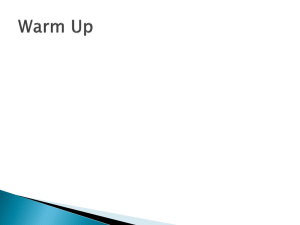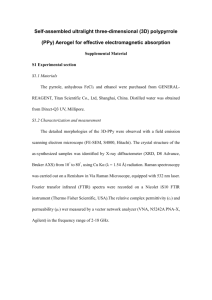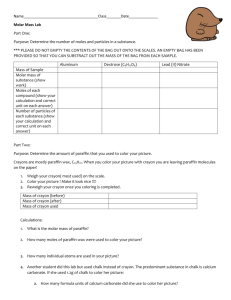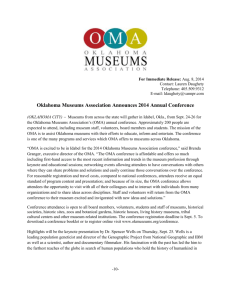Supplementary Information (docx 2660K)
advertisement
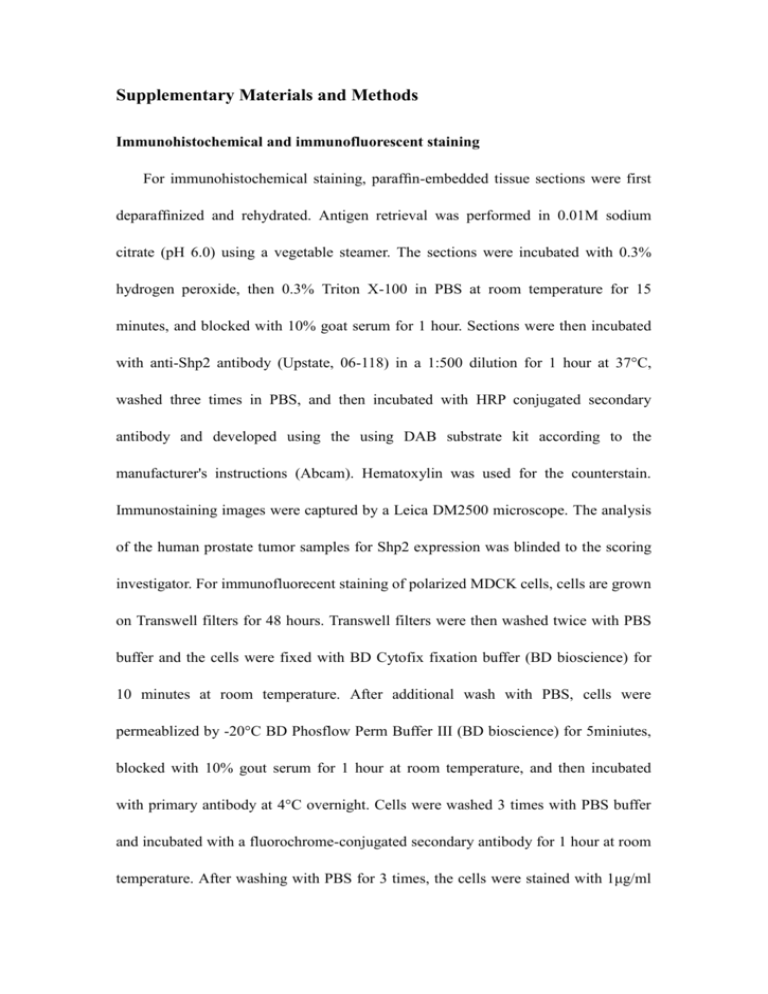
Supplementary Materials and Methods Immunohistochemical and immunofluorescent staining For immunohistochemical staining, paraffin-embedded tissue sections were first deparaffinized and rehydrated. Antigen retrieval was performed in 0.01M sodium citrate (pH 6.0) using a vegetable steamer. The sections were incubated with 0.3% hydrogen peroxide, then 0.3% Triton X-100 in PBS at room temperature for 15 minutes, and blocked with 10% goat serum for 1 hour. Sections were then incubated with anti-Shp2 antibody (Upstate, 06-118) in a 1:500 dilution for 1 hour at 37°C, washed three times in PBS, and then incubated with HRP conjugated secondary antibody and developed using the using DAB substrate kit according to the manufacturer's instructions (Abcam). Hematoxylin was used for the counterstain. Immunostaining images were captured by a Leica DM2500 microscope. The analysis of the human prostate tumor samples for Shp2 expression was blinded to the scoring investigator. For immunofluorecent staining of polarized MDCK cells, cells are grown on Transwell filters for 48 hours. Transwell filters were then washed twice with PBS buffer and the cells were fixed with BD Cytofix fixation buffer (BD bioscience) for 10 minutes at room temperature. After additional wash with PBS, cells were permeablized by -20°C BD Phosflow Perm Buffer III (BD bioscience) for 5miniutes, blocked with 10% gout serum for 1 hour at room temperature, and then incubated with primary antibody at 4°C overnight. Cells were washed 3 times with PBS buffer and incubated with a fluorochrome-conjugated secondary antibody for 1 hour at room temperature. After washing with PBS for 3 times, the cells were stained with 1μg/ml DAPI (Sigma) for 10 minutes at room temperature, and then mounted with Vector H-1000 mounting medium (Vector Laboratories, Inc,#H-1200). Immunostaining images were captured on a Leica SP5 II confocal microscope (Leica, Germany) with a 63 x Plan oil immersion objective. Z-stack x/y images were obtained with 1.5μm interval in a 30μm total depth with LAS AF Lite software (Leica Microsystems CMS GmbH) (Leica, Germany). More than 15 different fields were captured in each assay for analysis. Quantitative Real-time PCR One microgram of total RNA was used for reversed transcription for cDNA synthesis using PrimeScript RT reagent (Takara). SYBR green qPCR super mix (Toyobo) was used for quantitative PCR. Quantitative real-time PCR was performed on the Step one Plus Real-Time PCR Systems (Applied Biosystems). The primers for real time PCR were listed in the following table. Forward Primer 5’-3’ Reverse Primer 5’-3’ Ptpn11 GAACTGTGCAGATCCTACCTCT TCTGGCTCTCTCGTACAAGAAA E-cadherin CGAGAGCTACACGTTCACGG GGGTGTCGAGGGAAAAATAGG N-cadherin TCAGGCGTCTGTAGAGGCTT ATGCACATCCTTCGATAAGACTG Vimentin GACGCCATCAACACCGAGTT CTTTGTCGTTGGTTAGCTGGT Zeb1 GATGATGAATGCGAGTCAGATGC ACAGCAGTGTCTTGTTGTTGT Snail TCGGAAGCCTAACTACAGCGA AGATGAGCATTGGCAGCGAG Slug CGAACTGGACACACATACAGTG CTGAGGATCTCTGGTTGTGGT Twist GTCCGCAGTCTTACGAGGAG GCTTGAGGGTCTGAATCTTGCT actin CATGTACGTTGCTATCCAGGC CTCCTTAATGTCACGCACGAT Immunoprecipitation and immunoblotting For immunoprecipitation, cells were lysed in NP-40 lysis buffer (50mM Tris (pH7.4),150mM NaCl,1% NP-40) supplemented with the protease inhibitor cocktail, the phosphatase inhibitor cocktail (Thermo scientific) and 5mM NaF. Cell lysates were clarified at 12,000g for 10min at 4°C. For 293T cells, and 0.5-1mg total cell lysates were incubated with indicated antibodies or IgG at 4°C overnight. Protein A/G-plus Agarose beads (Roche) were then added and incubated for an additional 2 hours at 4°C. The immunoprecipitates were then washed three times with lysis buffer and boiled for 5 minutes at 98℃ in SDS loading buffer for subsequent immunoblotting. For the immunoprecipitation of endogenous PAR3 protein in DU145 and RWPE1 cells, 2mg of cell lysates and 2.5μg anti-PAR3 antibodies were used. For immunoblotting, the protein concentration was determined by a BCA assay (Bio-Rad). Proteins were separated by SDS-PAGE gels and transferred to a nitrocellulose membrane (Amersham). Membranes were first incubated in 5% fat free milk in TBS for one hour, and then incubated with indicated primary antibodies for 4 hours or overnight at 4˚C, followed by washing three times in TBS containing 0.8% Tween20. The membranes were then incubated with the HRP conjugated secondary antibody for 1 hour, and developed by the ECL reagent (Millipore). Antibodies against Shp2, HA-tag, Zeb1, N-cadherin, Slug, and Snail were all purchased from Cell Signaling Technology (the catalog number are #3397, #2367, #3396, #14215, #9585, #3879 respectively). Anti-E-cadherin was bought from BD (#610181). Antibody against Vimentin was purchased from Epitomics (#2707-1). Antibody against PAR3 and phosphotyrosine were purchased from Upstate (#07-330). Anti-ZO-1 antibody was purchased from Life Technologies (#339100). Anti-FAK antibody (#3285) and anti-phospho-FAK (Tyr397) (#3283) was purchased from Cell Signaling Technology. Antibody against β-actin(Cell Signaling Technology #4970) was used for immunoblotting internal control. Colony, sphere and epithelial lumen forming assays For the colony forming assay, single prostate cancer cells were plated on 6-well plates at densities of 500, 800, or 1000 cells/well in triplicates and cultured for 7-10 days. Colonies were fixed with 4% paraformaldehyde and stained with 0.1% crystal violet for 1 hour. For the sphere forming assay, prostate cancer cells were plated in 96-well ultra low cluster plates (Corning) at cell densities of 10, 50, or 100 cells/well in triplicates. After a two-week culture in DMEM:F12 medium (Gibco) supplemented with 20ng/ml EGF (peprotech), 20ng/ml FGF (peprotech) and 2% B27(Gibco), spheres were examined under a Nikon light microscope, and photographed. For epithelial lumen forming assay, single MDCK or RWPE1 cells were suspended in DMEM medium (containing 10% FBS) or KSFM medium (containing 5% FBS) with 2% Matrigel (BD Biosciences) at 1.5x104/ml. 200μL mixture was plated on Lab-Tek II chamber slides (Thermo Fisher Scientific) which were pre-coated with 50μL of Matrigel. The culture medium was changed every other day. The epithelial cysts were collected, fixed and subjected to immunofluorescent staining at 10 days or 20 days after plating for MDCK and RWPE1 cells respectively. Small molecule inhibitor treatment FAK inhibitor PF573228 was purchased from Medchem Express. DU145 cells were treated with 50nm PF573228 or equivalent amount of vehicle (DMSO) 24 hours before and during the migration assay. Shp2 inhibitor IIB-08 was purchased from Santa Cruz Biotechnology. To examine the effect of IIB-08 on prostate cancer growth in vivo, one week after the inoculation of DU145 cells, 100 mg/kg II-B08 were injected intraperitoneally each day for 7 consecutive days into tumor bearing nude mice. Tumor size was monitored each week for 3 weeks after the treatment. Mice were sacrificed at 4 weeks after inoculation and then the tumors were collected and imaged. Real time cell recording and imaging Real time cell migration analysis was performed on Xcelligence Real-Time Cell Analyzer DP instrument. 3x104 cells were seeded in the upper chamber and of the CIM-16well plates (Roche Applied Science). The Kinetics of the cell migration was recorded every 15 min. Real time microscopic imaging was used to record cell mobility. Cells were plated on LAB-TEK glass-bottom dishes (Thermo Fisher Scientific) at around 20% confluence and cultured in the IX3W TOKAI HIT time-lapse system installed in an IX83 Olympus Fluorescent microscope. Differential interference contrast images were captured with a 10x objective lens at a 10 min interval continuously for 2 days. Then the video was analyzed by the CellSens Dimension 1.9 software from Olympus. Supplementary Figure 1. Expression levels of Shp2 in different prostate cancer cell lines. Immunoblotting result shows higher Shp2 expression levels in PC3 and DU145 cells than LnCap cells. Supplementary Figure 2. Shp2 knock down using a second shRNA sequence leads to suppressed prostate cancer cell growth and metastasis. A. Efficient knock down of Shp2 by shRNA #2 lentivirus is confirmed by immunoblotting. B. shShp2 #2 lentivirus transfection represses the cell cycle progression of DU145 cells. (n=3) C. Shp2 gene silencing by shShp2 #2 suppresses xenograft tumor growth of DU145 cells in vivo. (n=10) D. Shp2 knockdown by shShp2 #2 leads to reduced DU145 cell migration. (scale bar is 50μm) E. Shp2 knockdown by shShp2 #2 inhibits metastasis of PC3 cells in vivo. (n=7 in scramble group, n=9 in shShp2 #2 group) (****P < 0.0001, *** P < 0.001, ** P < 0.01,* P < 0.05, data are shown as means +/S.E.M.) Supplementary Figure 3. Upregulated Shp2 promotes migration and motility of prostate cancer cells. A. WT-Shp2 or DA-Shp2 expression causes enhanced prostate cancer cell motility. LnCap cells transfected with control, WT-Shp2 or DA-Shp2 retrovirus were plated at around 20% confluence and monitored by a microscopic time-lapse system. Cell migration distance at 48hours after the initiation of recording was measured. At least 25 cells per each group were followed and counted. B. The kinetic information of the migration of LnCap cells transfected with control, WT-Shp2 or DA-Shp2 retrovirus was recorded using Xcelligence real-time cell analysis. Overexpression of WT-Shp2 or DA-Shp2 leads to accelerated cell migration (n=4). (****P < 0.0001, ** P < 0.01,* P < 0.05, data are shown as means +/- S.E.M.) Supplementary Figure 4. Effect of FAK activity inhibition on the migration of scramble shRNA or shShp2 tranfected DU145 cells. A. Impact of Shp2 knock down on the phosphorylation level of FAK at Y397. Scramble RNA or shShp2 tranfected DU145 cells were serum starved for 8 hours and unstimulated or treated with 100ng/ml EGF for 10 minutes. Cell lysates were analyzed by immunoblotting with anti-phospho-FAK (Y397), anti-FAK, anti-Shp2 and anti-actin antibodies B. Inhibition of FAK activity by PF573228 does not rescue the suppression of DU145 cell migration caused by Shp2 silencing. DU145 cells were treated with 50nm PF573228 or vehicle 24 hours before and during the migration assay. (scale bars are 50μm) (*** P < 0.001, ** P < 0.01,* P < 0.05, data are shown as means +/- S.E.M.) Supplementary Table 1. Clinical features of prostate cancer samples in this study. Patient Number Age Gleason score 1 62 6 2 80 7 3 81 5 4 57 6 stage Ⅱ Ⅱ-Ⅲ adeno carcin oma adeno carcin oma adeno carcin oma adeno carcin oma adeno carcin oma adeno carcin oma adeno carcin oma adeno carcin oma adeno carcin oma adeno carcin oma adeno carcin oma adeno carcin oma adeno carcin oma adeno carcin oma adeno carcin oma adeno carcin oma cancer Ⅱ-Ⅲ Ⅱ-Ⅲ Ⅰ-Ⅱ Ⅱ Ⅱ-Ⅲ 5 7 Ⅱ 6 80 6 7 68 5 8 76 7 9 76 8 10 76 4 11 66 5 Ⅰ-Ⅱ Ⅱ-Ⅲ Ⅲ-Ⅳ Ⅰ Ⅱ Ⅱ-Ⅲ 12 7 Ⅱ 13 53 6 14 80 9 15 71 5 16 55 5 17 62 7 18 72 7 19 72 5 20 55 8 Tumor type Ⅲ-Ⅳ Ⅰ-Ⅱ Ⅱ PSA ng/ ml NA NA NA NA NA NA NA NA NA NA NA NA NA NA NA NA TNM NA NA NA NA NA NA NA NA NA NA NA NA NA NA NA NA NA NA cancer NA NA Ⅱ cancer NA NA Ⅱ-Ⅲ cancer NA NA Sample type Shp2 up-regulation Shp2 down-regulation or no change Paraffin embedded √ Paraffin embedded √ Paraffin embedded √ Paraffin embedded √ Paraffin embedded √ Paraffin embedded Paraffin embedded √ √ Paraffin embedded Paraffin embedded √ √ Paraffin embedded √ Paraffin embedded √ Paraffin embedded √ Paraffin embedded √ Paraffin embedded √ Paraffin embedded √ Paraffin embedded √ Paraffin embedded Paraffin embedded Paraffin embedded Paraffin √ √ √ √ embedded 21 74 5 22 69 6 23 75 7 24 71 4 25 68 5 26 74 5 27 67 6 28 56 7 29 65 4 Ⅱ cancer NA NA Ⅱ cancer NA NA Ⅱ cancer NA NA Ⅱ cancer NA NA Ⅰ-Ⅱ adeno carcin oma adeno carcin oma adeno carcin oma adeno carcin oma adeno carcin oma adeno carcin oma NA NA adeno carcin oma 5.39 adeno carcin oma 8.78 adeno carcin oma 20.9 7 adeno carcin oma 22.7 2 adeno carcin oma 9.7 adeno carcin oma 55.7 73 adeno carcin oma NA adeno 13.4 Ⅱ Ⅱ Ⅰ Ⅰ-Ⅱ NA 30 64 9 NA 31 51 8 NA 32 70 6 NA 33 65 6 NA 34 63 9 NA 35 68 8 NA 36 68 7 NA 37 55 6 38 65 6 NA NA NA NA NA 6.8 NA NA NA NA NA T2bn0 m0 T2cn0 m0 T2cn0 m0 NA T3bn1 m0 T2an0 m0 NA T2bn0 Paraffin embedded Paraffin embedded Paraffin embedded Paraffin embedded Paraffin embedded √ √ √ √ √ Paraffin embedded √ Paraffin embedded √ Paraffin embedded √ Paraffin embedded √ Fresh sample from surgical removal Fresh sample from surgical removal Fresh sample from surgical removal Fresh sample from surgical removal Fresh sample from surgical removal Fresh sample from surgical removal Fresh sample from surgical removal Fresh sample from surgical removal Fresh √ √ √ √ √ √ √ √ √ carcin oma NA 39 74 6 NA 40 56 8 NA 41 70 9 NA 42 65 6 NA 43 total 73 6 m0 adeno carcin oma 13.6 2 adeno carcin oma 17.5 2 adeno carcin oma NA adeno carcin oma 4.16 adeno carcin oma 8.62 T2cn0 m0 NA NA T1cn0 m0 T2an0 m0 sample from surgical removal Fresh sample from surgical removal Fresh sample from surgical removal Fresh sample from surgical removal Fresh sample from surgical removal Fresh sample from surgical removal √ √ √ √ √ 26 17 (No.1-29 patient samples were used for the IHC staining. No.30-43 patient samples were used for the immunobloting analysis.) Supplementary Video 1. Time-lapse recording video of LnCap cells transfected with control retrovirus. Supplementary Video 2. Time-lapse recording video of LnCap cells transfected with WT-Shp2 retrovirus. Supplementary Video 3. Time-lapse recording video of LnCap cells transfected with DA-Shp2 retrovirus.


